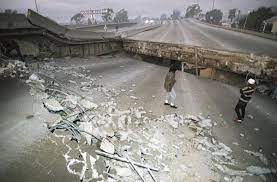On January 17, 1994, a powerful earthquake, known as the Northridge earthquake, struck the Los Angeles area, leaving a trail of destruction and reshaping the landscape of Southern California. With a magnitude of 6.7, the earthquake's epicenter was located in the San Fernando Valley, near the community of Northridge. This seismic event would go on to become one of the most significant earthquakes in recent Californian history, causing widespread damage and prompting a reevaluation of earthquake preparedness and building codes. The Northridge earthquake struck at 4:31 a.m. local time, catching residents and the city off guard as they slept. The shaking lasted for about 10 to 20 seconds, but its impact was immense. The earthquake caused severe damage to buildings, bridges, and infrastructure across a wide area, with the San Fernando Valley particularly hard-hit. Numerous homes, commercial structures, and apartment buildings suffered structural damage or collapsed entirely. The collapse of a section of the Interstate 5 and the loss of critical transportation routes highlighted the vulnerability of California's infrastructure to seismic events. The destruction of the freeway demonstrated the potential economic and logistical consequences of a major earthquake in a densely populated urban area. The Northridge earthquake resulted in significant casualties, with 57 people losing their lives and over 8,700 sustaining injuries. Thousands of residents were displaced as homes were rendered uninhabitable. The economic toll of the disaster was staggering, with estimates of property damage exceeding $20 billion. Insurance claims soared, and businesses faced prolonged disruptions as they struggled to recover from the aftermath. The earthquake also exposed flaws in building construction and design standards. Many structures that sustained the most damage were found to have been built before the implementation of more stringent seismic codes. Consequently, the disaster prompted a reassessment of building practices and the implementation of stricter regulations to enhance earthquake resistance. In the wake of the Northridge earthquake, significant efforts were made to improve seismic safety in Southern California. The state and local governments initiated comprehensive reviews of building codes, retrofitting requirements, and emergency response protocols. Engineers and architects developed innovative techniques to strengthen existing structures and ensure the earthquake resilience of new constructions. The disaster had a lasting impact on public awareness and preparedness for seismic events. It underscored the need for individuals and communities to be proactive in earthquake readiness, including securing furniture, creating emergency kits, and developing family evacuation plans. The Northridge earthquake remains a pivotal event in the history of seismic activity in California. It served as a wake-up call for policymakers, engineers, and residents alike, prompting a reevaluation of seismic risks and a commitment to creating more resilient communities. The lessons learned from the Northridge earthquake continue to inform earthquake preparedness and response strategies in earthquake-prone regions around the world.
17 january 1994 Los Angeles Earthquake
